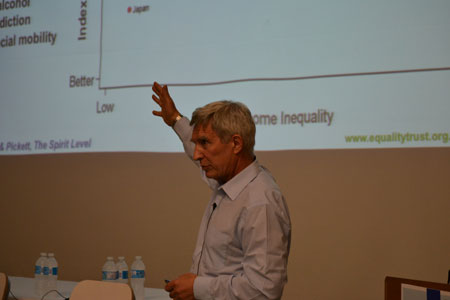
Many of us today at the Wellesley Institute were fortunate to catch Richard Wilkinson’s lecture, courtesy of MASS LBP and the Dalla Lana School of Public Health at the University of Toronto. It reminded us of several things, including why the project of solving income inequality is so important, not only socially and economically, but also for our health.
Richard Wilkinson and Kate Pickett ignited the conversation that economic inequality harms societies three years ago with their book The Spirit Level: Why Equality Is Better For Everyone. The difference from previous decades, Wilkinson says, about income inequality and its harmful effects on society is that now we have the research to prove the links between income and health. Wilkinson and Pickett brought this conversation to the forefront when people still weren’t linking income inequality to the kinds of social and health problems we’re seeing across societies today. And, they certainly weren’t talking about it.
While high income doesn’t necessarily equal good health, low income almost certainly equals poor health, says a study by the Wellesley Institute in 2011, Poverty is Making Us Sick. We know that poor health is linked to poverty in Ontario and that the causes of the causes of bad health can be traced back to our housing, the condition of our neighbourhoods, our access to healthy food, whether we belong to healthy communities, have strong social circles, have access to a high quality education, and many other factors.
As Dr. Arlene King, Ontario’s Chief Medical Officer of Health and a panel respondent in today’s discussion noted, poor health is often a social disease with a medical element.
In The Spirit Level, Wilkinson and Pickett highlight that not only are there jarring differences in life expectancy between rich poor countries across the globe, but these differences also exist within the so-called rich developed nations.
A great example from Wilkinson’s presentation was social mobility within nations. He demonstrated that social mobility – a critical measure of whether people with low income are able to move up the social ladder – is lowest in the United States and highest in Denmark. As a result, Wilkinson joked, to achieve the American Dream, US citizens should go to Denmark.
Sick and Tired, a report funded in part by the Wellesley Institute, which came out in 2009, revealed that people on social assistance and the working poor in Ontario have much higher rates of chronic illness, up to seven times, than their non-poor counterparts. Our ongoing work about reforming the social assistance system includes a focus on ensuring that people on social assistance have adequate incomes.
One important message from Wilkinson’s presentation was that addressing inequality does not have a single simple fix. Wilkinson noted that Sweden and Japan – two rich countries that have low levels of income inequality – took widely divergent paths. Sweden favours a strong welfare state and higher taxes to create less income inequality after tax, while Japan has lower taxes and less income inequality between those at the top and those at the bottom before tax.
This is a message to keep in mind while addressing inequality in Canada. We know that the gap between the richest and poorest is growing and we can look to what has worked in more equal societies for cues to reverse this trend. Wilkinson ended his presentation by arguing that we’ve known about this problem for decades – now it’s time for us to act.